
For over a year we’ve been living in a world gripped by the COVID-19 pandemic. Not only has the pandemic affected people’s lifestyles, it has also accelerated the development and implementation of technologies that make it easier for us to complete everyday and work-related tasks. We no longer need to fly halfway around the world to attend a conference. Nor do we need to leave the house to buy things like food or household cleaning products. Children can now attend school remotely, and more and more adults are getting used to working from home. We do not know how much longer we will be living like this or what life will look like after the pandemic. But one thing is clear: no matter what happens, people are unlikely to give up existing technologies.
Children master new technologies and are adapting to the digital society faster than adults. In fact, they are the digital society. In this report we try to understand what occupied the younger generation during the last year, from May 2020 to April 2021 inclusive. We will see what children were engrossed in during their leisure time when they were fixated on their smartphones, how and where they tapped into their creativity, what they were listening to and who their favorite YouTube blogger was. At the same time, we will try to remember what we were like at their age and understand that in essence, they are passionate about the same things we were, only in a new, digital form.
How we collect our statistics
Website categorization
Kaspersky Safe Kids module included into our solutions for home users scans the contents of web pages that children try to visit. If the site falls into one of 14 undesirable categories, the product sends an alert to Kaspersky Security Network. In doing so, no personal data is transmitted and user privacy is not violated. Note:
- It is up to the parent to decide which content to block by tweaking the protective solution’s preferences. However, anonymous statistics are collected for all the 14 categories.
- The information in this report was obtained from computers running Windows and macOS.
Web filtering in Kaspersky Safe Kids currently covers the following categories:
- Software, audio, video
- Internet communication
- Videogames
- Online stores, banks, payment systems
- News media
- Job search
- Adult content
- Profanity, obscenity
- Weapons, explosives, pyrotechnics
- Religions, religious associations
- Gambling, lotteries, sweepstakes
- Alcohol, tobacco, narcotics
- Anonymizers
- Violence
Search query filtering
Looking at children’s search activity is the best way to see what they are interested in. Kaspersky Safe Kids can filter kids’ queries in five search engines (Bing, Google, Mail.ru, Yahoo!, Yandex), as well as on YouTube. Filtering targets six potentially dangerous topics: Adult content, Alcohol, Narcotics, Tobacco, Racism and Profanity.
This report presents statistics on YouTube searches. The TOP 1,000 search queries collected from YouTube over the period from November 2020 to April 2021, inclusive, was taken as 100%. The ranking was based on the number of times a query was input, without breakdown by region or language. The popularity of a topic is determined by its share of related queries.
We divided the search queries collected from November 2020 to April 2021 into the following subject categories:
- Games
- YouTube bloggers
- Music
- Movies, cartoons and TV shows
- Trends
- Gacha Life
- Hobbies and creation
- Memes
- Anime
- TikTok
- Sports
- Toys
- Adult content
- Educational content
- Miscellaneous
Control the use of programs
Kaspersky Safe Kids allows parents to control and limit the amount of time their children spend on apps and programs on their devices. This study draws on anonymized data on the number of hours children spent on apps on devices running the Android operating system in different regions and countries, as well as in the world as a whole.
We determined the 10 most popular apps for each of the regions and countries we examined, as well as for the entire world. For each set of 10, we took as 100% the sum of the hours spent on these apps. The percentage breakdown in the TOP 10 reflects the number of hours spent on each app.
Picture of the world
Website categories
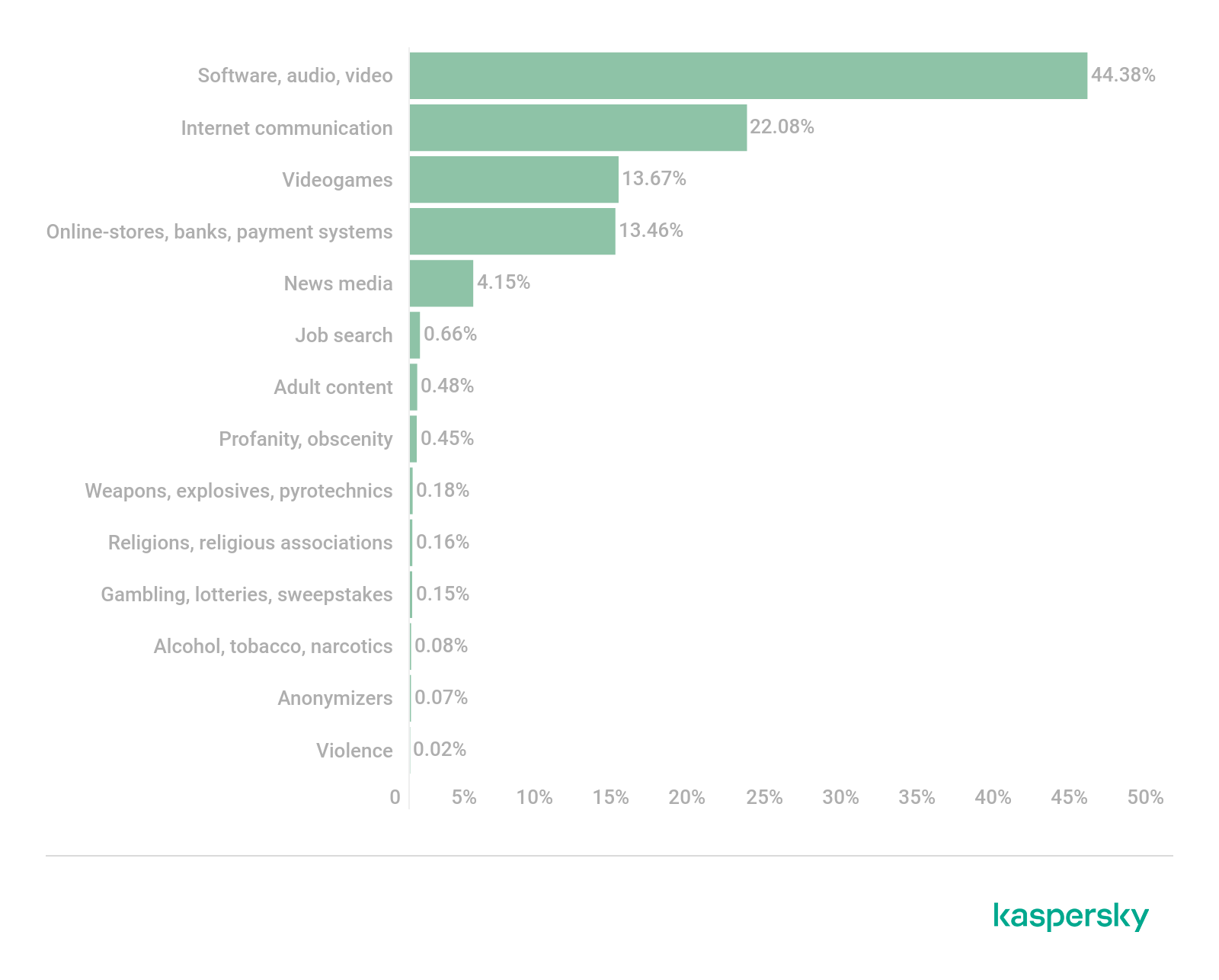
Distribution of Kaspersky Safe Kids alerts by category, May 2020 through April 2021 (download)
Android apps
To get a fuller picture of children’s interests, it is useful to look at the 10 mobile apps on which children across the world spent most of their time during the period covered by this study. YouTube was the decisive leader, with 32.17%. This again confirms that YouTube was the most sought-after service among children. WhatsApp, a messaging service, was number two with 18.07%, and was followed by TikTok, the world’s most popular social network, with 14.96%.

10 most popular Android apps, November 2020 through April 2021 (download)
YouTube search queries
As the data by website category shows, the most visited category was “Software, audio, video”, and this includes YouTube, the most popular website among children across the world. YouTube was also the most popular mobile app. To delve more deeply into children’s interests, it is useful to examine what they are searching for on YouTube.
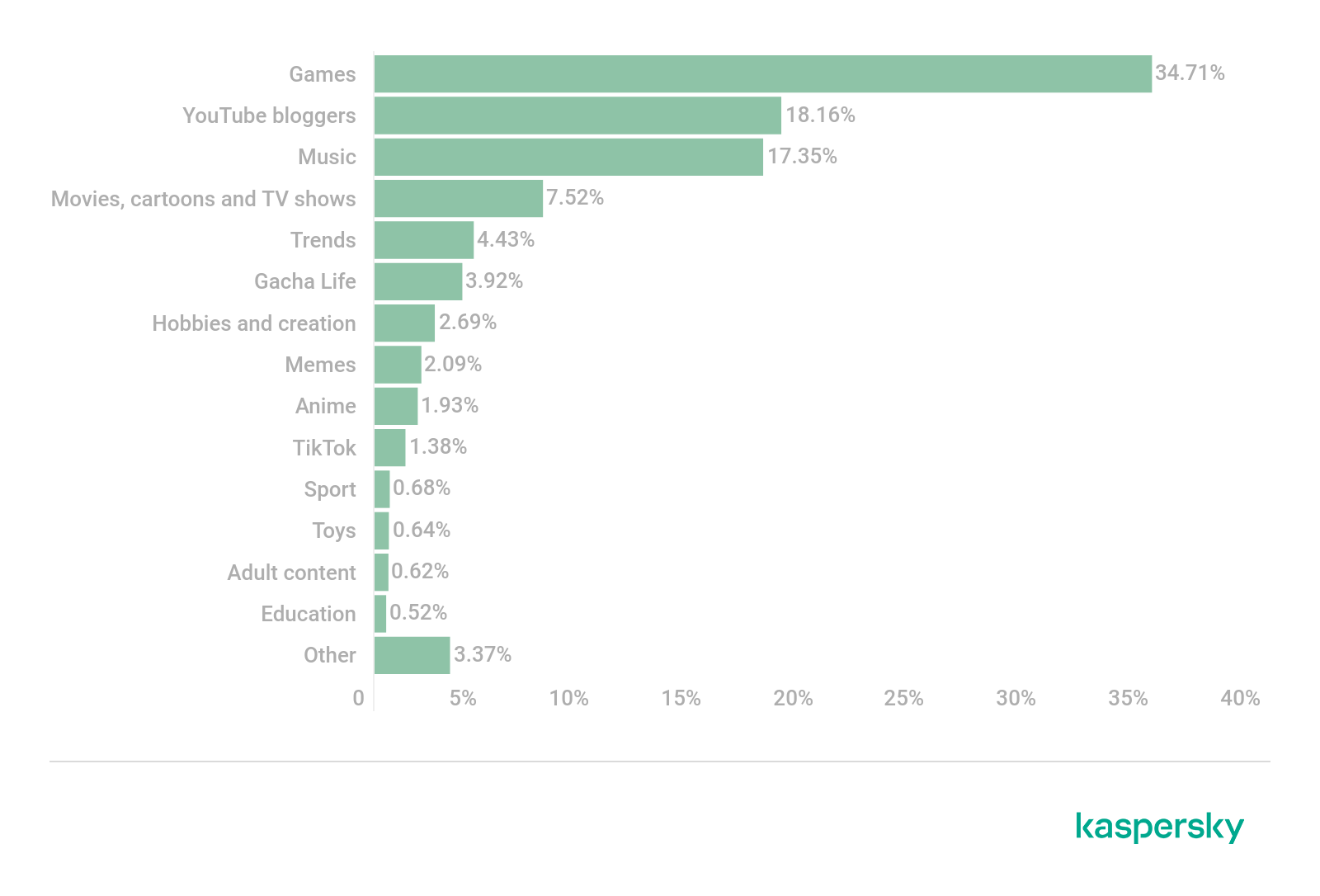
Distribution of YouTube searches by subject category, November 2020 through April 2021 (download)
As we analyzed the most popular search queries by children around the world, we noted a large number of searches on the video game maker Gacha Life. We separated these queries into a standalone topic.
In addition to pure entertainment, children were searching for videos on YouTube that inspired them to be creative. Queries related to making things with their hands, drawing, dances and other creative endeavors represented 2.69% of searches. This was even higher than the share of memes, which typically interest children, and which were the subject of 2% of searches between November 2020 and April 2021.
Software, audio, video
We will now look more closely at the most popular category of websites, “Software, audio, video”.
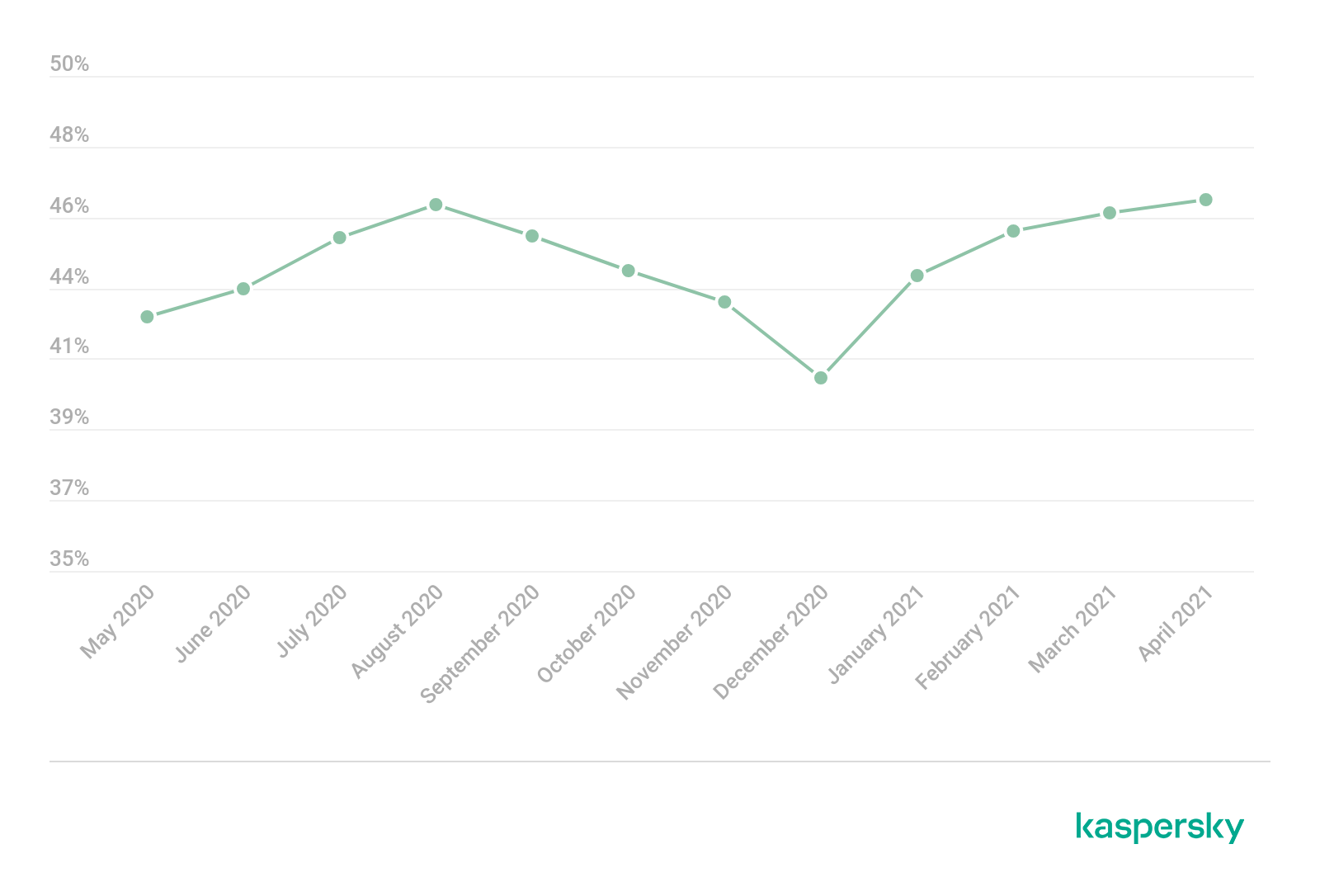
Change in number of Kaspersky Safe Kids alerts for “Software, audio, video” category, May 2020 through April 2021 (download)

Share of Kaspersky Safe Kids alerts for “Software, audio, video” category out of all alerts on children’s devices by region, May 2020 through April 2021 (download)

Share of Kaspersky Safe Kids alerts for “Software, audio, video” category out of all alerts on children’s devices by country, May 2020 through April 2021 (download)
We already know that the most popular website and app in the “Software, audio, video” category is YouTube. At the same time, nowadays mobile phones are used much more often than PCs, so to get a complete picture we must consider the statistics for mobile apps. We studied how much time children in different regions and countries spent on the YouTube, YouTube Kids and Netflix apps.

Share of time children spent on the YouTube app out of the total time they spent on the 10 most popular apps by region, November 2020 through April 2021 (download)

Share of time children spent on the YouTube app out of the total time they spent on the 10 most popular apps by country, November 2020 through April 2021 (download)
In addition to the basic YouTube app, there is a special children’s app, YouTube Kids, but it did not make the list of TOP 10 Android apps on which children spent the most time in all the countries.

Share of time children spent on the YouTube Kids app out of the total time they spent on the 10 most popular apps by country, November 2020 through April 2021 (download)

Share of time children spent on the Netflix app out of the total time they spent on the 10 most popular apps by country, November 2020 through April 2021 (download)
What exactly are children watching and listening to on YouTube? In addition to videos on computer games and other topics we will examine below, the most popular categories of search queries were “Music” and “Movies, cartoons and TV shows.”
In terms of music, children very often searched for the K-pop groups Blackpink and BTS, and the American stars Ariana Grande, Travis Scott and Billie Eilish. Children were also interested in specific music genres. For example, based on the number of searches, phonk was rather popular. Children were not just listening to music — they were also trying to make it. The names of different beats and samples, and lessons on creating music in specialized programs, began showing up more often among the popular search queries in all languages. It is important to note that the social network TikTok has an outsized influence on children’s musical preferences as well as on the industry as a whole, so a track that is lucky enough to go viral on TikTok becomes a hit. This is what happened with “SugarCrash!” by ElyOtto, “Astronaut in the Ocean” by Masked Wolf and even “Rasputin” by Boney M., which got a second life thanks to the game Just Dance as well as to a TikTok challenge that went viral and propelled this track to the ranks of the “popular.”

Distribution of search queries on YouTube for “Movies, cartoons and TV shows,” November 2020 through April 2021 (download)
Internet Communication Media
As was typical, the “Internet communication” category of websites was second in terms of number of visits from PCs, with 22.08%.

Change in number of Kaspersky Safe Kids alerts for “Internet communication” category, May 2020 through April 2021 (download)

Share of Kaspersky Safe Kids alerts for “Internet communication” category out of all alerts on children’s devices by region, May 2020 through April 2021 (download)

Share of Kaspersky Safe Kids alerts for “Internet communication” category out of all alerts on children’s devices by country, May 2020 through April 2021 (download)
We had always predicted that online communication was shifting increasingly from PCs to mobile platforms. Most social networks are much more convenient to use on mobile devices. Moreover, the new platforms appearing and being developed in the last few years are sometimes designed exclusively for mobile devices. One example is the ultrapopular social network TikTok, which does have a web version, but it has limited options. In addition, a convenient platform for communication is messaging apps, which are also used more frequently on phones.
We can now back up our hypotheses with numbers, having analyzed which social networks and messaging apps were among the 10 most popular Android apps in terms of the amount of time children spent on them.
The most popular means of communication among children all over the world was WhatsApp, at 18.07%, and it was the second most popular app downloaded on children’s Android devices in the world.

Share of time children spent on WhatsApp out of the total time they spent on the 10 most popular apps by region, November 2020 through April 2021 (download)
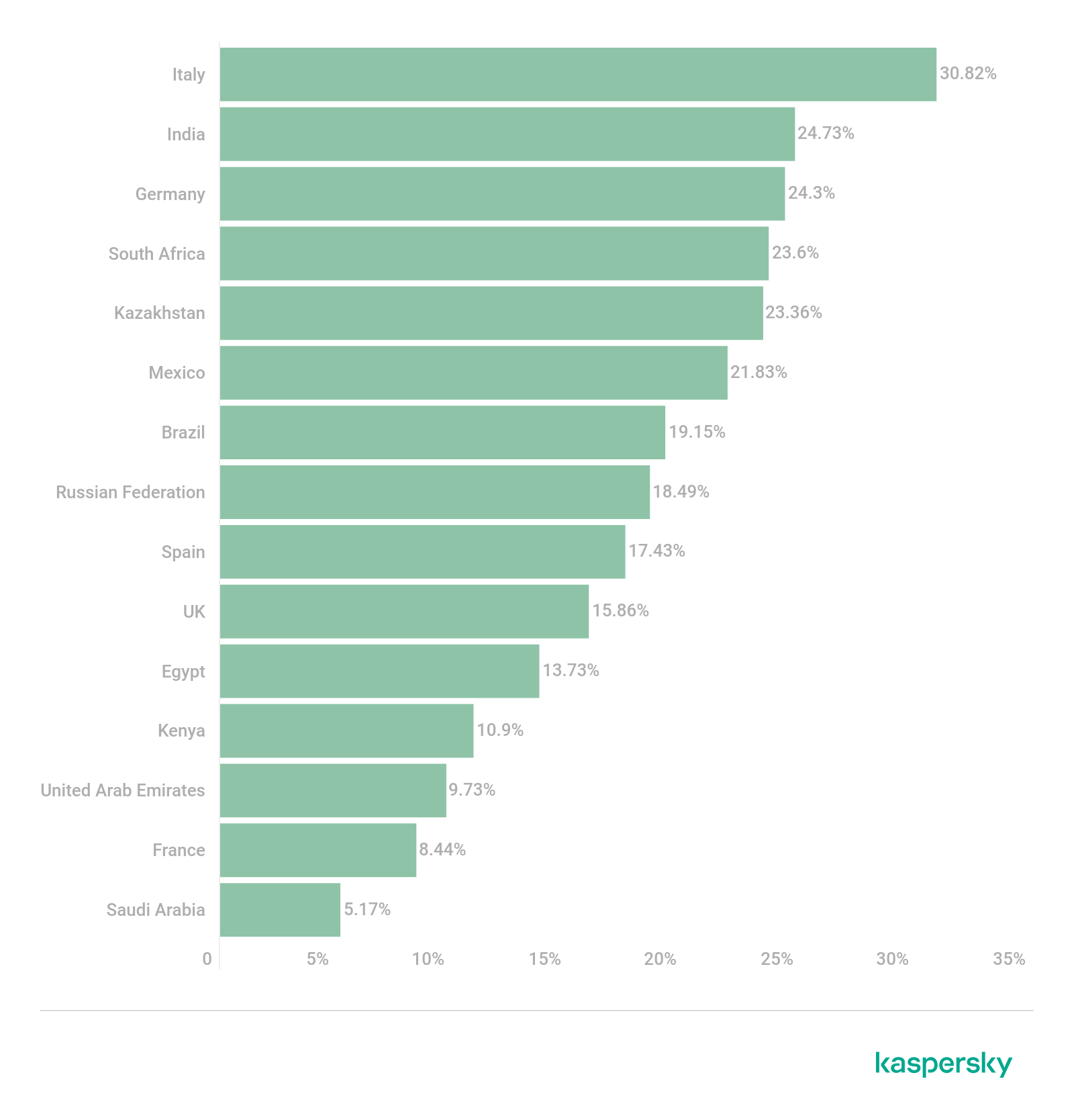
Share of time children spent on WhatsApp out of the total time they spent on the 10 most popular apps by country, November 2020 through April 2021 (download)
In some regions and countries, Zoom — for which demand soared amid the pandemic — made the list of TOP 10 apps. The share of this app compared to other apps children gravitated to was not very high, but it should be noted that children actively used it in South Asia (6%), the Arab world (3.84%) and East Asia (3.48%).

Share of time children spent on the Zoom app out of the total time they spent on the 10 most popular apps by country, November 2020 through April 2021 (download)
Another well-known messaging app, Viber, was among the 10 most used apps in only two countries: Belarus (18.90%) and the Russian Federation (4.74%).
TikTok is currently the most popular social network. Of the 10 mobile social networks most used by children across the world, TikTok topped the list with 14.96%, far outpacing Instagram, which was second with 4.86%.

Share of time children spent on the TikTok app out of the total time they spent on the 10 most popular apps by region, November 2020 through April 2021 (download)
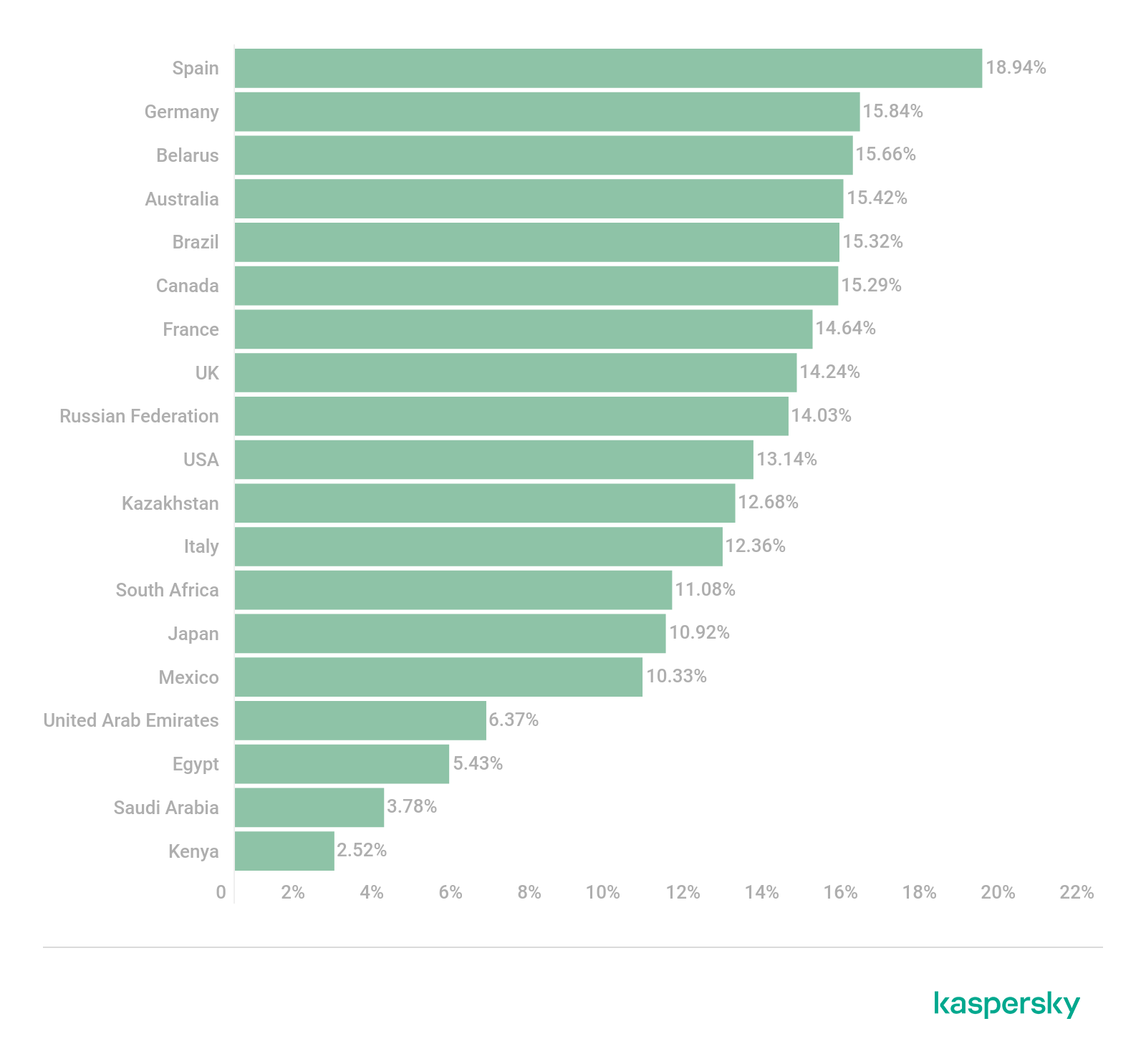
Share of time children spent on the TikTok app out of the total time they spent on the 10 most popular apps by country, November 2020 through April 2021 (download)
Children’s fascination with TikTok should not be viewed as unequivocally harmful. To record a video that will trend and become popular, users need to, at a minimum, learn a dance move or write a script, and to produce an idea they need to compose the shot, set up lighting, select a perspective and choose musical accompaniment. As a result, the child is acting as the cameraperson, actor, director, costume designer and an entire film crew. It goes without saying that this helps build skills that may not just be useful in the future but could also become a profession.
As for the content that children consume on TikTok, it becomes more varied by the day as the social network attracts more and more content producers. We recently wrote about how TikTok can be used as an educational resource. This is only one part of what you can find there. TikTok more or less has something for everyone — from dances to tips on bedding seeds at your summer cottage to digital art.
Lately Instagram, which until recently was wildly popular, has been losing popularity among children and is being sidelined. Children spent an average of one-third less time on Instagram than on TikTok.

Share of time children spent on the Instagram app out of the total time they spent on the 10 most popular apps by region, November 2020 through April 2021 (download)
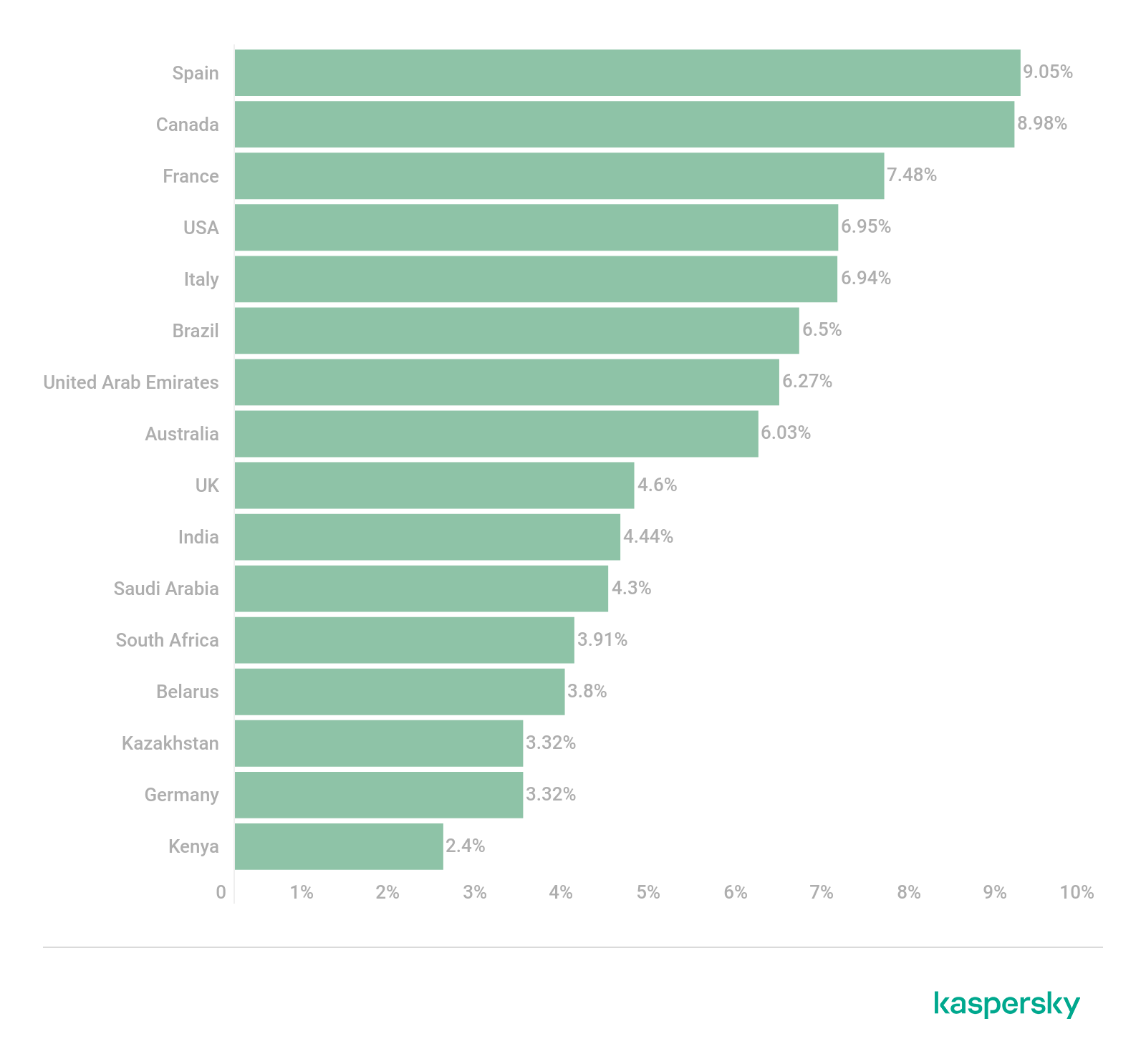
Share of time children spent on the Instagram app out of the total time they spent on the 10 most popular apps by country, November 2020 through April 2021 (download)
We cannot neglect another social network whose functionality is reminiscent of Instagram and, to a lesser extent, TikTok. This is the progenitor of the animal filters: SnapChat. SnapChat made the list of 10 most popular Android apps in only a few countries.

Share of time children spent on the SnapChat app out of the total time they spent on the 10 most popular apps by country, November 2020 through April 2021 (download)
Facebook is far from the favorite social network among children. Nevertheless, Facebook enjoys some popularity among children in Egypt (10.08%), Mexico (5.9%) and India (2.87%). Facebook did not make the list of the 10 most popular apps in terms of time in the other countries.
This was also the case for the Russian social network VKontakte, which was once very popular among children. It made the TOP 10 only in the Russian Federation, with 5.32%, a small proportion compared to TikTok’s 14.03%.
Videogames

Change in number of Kaspersky Safe Kids alerts for “Videogames” category, May 2020 through April 2021 (download)

Share of Kaspersky Safe Kids alerts for “Videogames” category out of the total alerts on children’s devices by country, May 2020 through April 2021 (download)
To understand which games children are most interested in, we must look at the searches they performed on YouTube, where, as we note above, games were their top interest, accounting for 34.71% of search queries.

Distribution of search queries for game topics on YouTube, November 2020 through April 2021 (download)
Children were most interested in Minecraft (22.84%); Fortnite (6.73%), which was nominated for Favorite Video Game in the Nickelodeon Kids’ Choice Awards in 2021; Among Us, which won that award (3.80%); Brawl Stars, which recently captured children’s attention (6.34%); and Roblox, a very popular game and longtime favorite (3.82%).
All these games also have mobile versions, and some of them were among the 10 most popular apps in many countries. Roblox was the game that most often made the TOP 10.

Share of time children spent on the Roblox app out of the total time they spent on the 10 most popular apps by country, November 2020 through April 2021 (download)

Share of time children spent on the Brawl Stars app out of the total time they spent on the 10 most popular apps by country, November 2020 through April 2021 (download)
We cannot ignore the game Among Us, which hooked children over the world in 2020–2021. The game is a reimagined analog of the well-known game Mafia. The only difference is that it can be played without leaving the house, and in a world where a pandemic is raging, this is more convenient than ever.
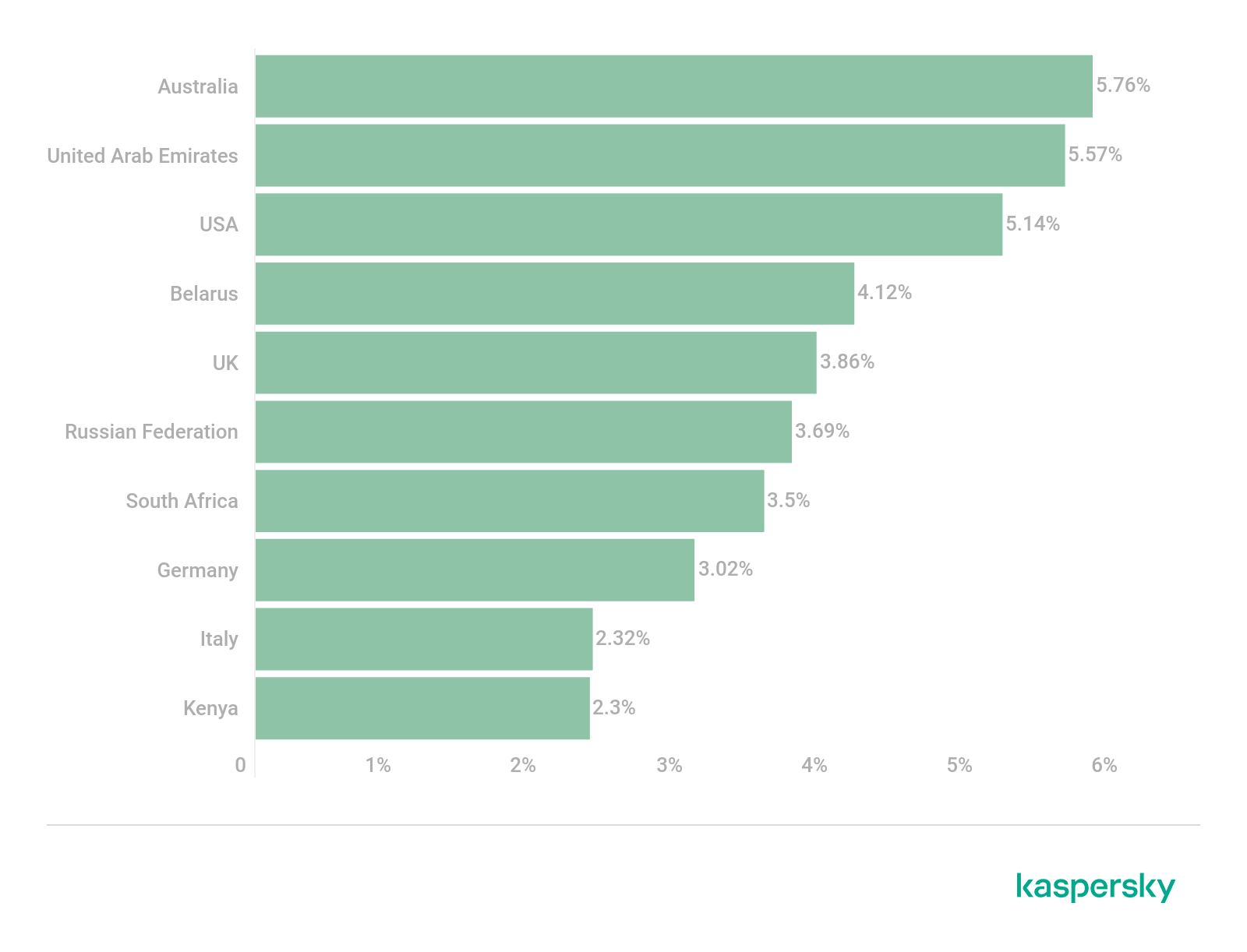
Share of time children spent on the Among Us app out of the total time they spent on the 10 most popular apps by country, November 2020 through April 2021 (download)
Children did not seem to enjoy playing Minecraft on mobile devices. This game made the TOP 10 apps in only three countries: UAE (2.51%), South Africa (2.23%) and Belarus (4.19%). However, it would be a mistake to think that Minecraft is losing popularity. Based on YouTube search queries, it is still the number one game for children in the world. Since it is present on nearly all devices, including game consoles — among them Nintendo Switch, which is popular with children — children are most likely choosing to play Minecraft on consoles and PCs.
Gacha Life
In 2020–2021 we noticed that children began showing more interest in the game Gacha Life. After analyzing the search queries, we decided to separate it into a standalone item because in essence it is not just a game, but also a platform for creating animations that children watch almost more often than they play the game. Nearly 4% of all children’s YouTube searches analyzed were for Gacha Life.
The principle is that using the game’s existing interface, users can easily create characters, place them in specific locations and write dialogue for them. The game offers complete creative freedom, and children and adolescents — and sometimes even adults — take advantage of it to create animations on a wide range of topics with different characters, upload them to YouTube and get thousands of views. On the one hand, this develops the imagination, and on the other, children enjoy watching animations created by other children on topics that interest them and are relevant to them.
Meme
We also opted to separate children’s interest in memes. Search queries on memes made up slightly more than 2% of all of children’s YouTube searches analyzed here, but because children frequently input some of the search queries, we are considering them in this report. The most popular terms in these searches were meme animation, memes, mouse sausage and polish cow.
Between November 2020 and April 2021, the clear leader in search queries for memes was the Polish cow video. The most popular video with the “Polish cow” was Dancing Polish Cow 10 Hours, which got more than 18 million views. It does in fact last 10 hours. In this video and other “Polish cow” videos, the eponymous animal dances to a song in Polish. It is best not to read the lyrics, which are about drugs. But before you rush to block all videos with the Polish cow, it is important to understand two things: first, the vast majority of children do not understand the lyrics because they are in Polish, so for them it is just a strange and funny song, and second, children do not take memes as instructions on how to behave, just as in our time hits by the Beatles and Rolling Stones did not spur us to take drugs.
Siren Head
Since time immemorial, children have loved listening to and telling scary stories. Consuming scary stories in moderation is not dangerous — it just gets our adrenaline running under safe conditions. In the past, people told these stories around the campfire, but now, thanks to YouTube, you do not need to travel far to hear one.
A frequent term in children’s search queries was the character Siren Head. A search for this term brings up many videos by the bloggers who are most popular among children with stories about this character. Once upon a time, stories about Slenderman circulated on the Internet. Siren Head has now supplanted him in the ranking of mystical scary creatures.
So if you want to entertain a child with a scary story around the fire at your summer house, think up a story about Siren Head. Just don’t try too hard.
Conclusion
These days we are seeing that children are not only consuming content, but also trying their hands at creating it. Just a few years ago, drawing animations was complicated, but now anyone can install Gacha Life and create even the most rudimentary script and upload a cartoon to YouTube. If you want to dip your toe into music, you no longer need to spend years learning to play the guitar or drums. All you need to do is open special software and learn to tell the difference between kick and snare. These activities are not mutually exclusive, and in the future a child may become seriously interested in music and learn to play one or more instruments. As for creating videos, thanks to TikTok, children are getting inspired and learning not only to shoot interesting videos but also to edit, direct, and set up the shot and lighting.
It is true that everything has become simpler, but who said that was a bad thing? Rather, today’s children can explore different areas in a short period of time. By the time they need to figure out what they want to be when they grow up, they will already have an idea of what they are interested in, what they are not interested in, what they are good at, and what they are not good at, and they will dedicate themselves to an activity they like and are successful at.
Even if you think your child is interested in something suspicious or something you do not understand, do not rush to block access to online resources. First talk to your child: it is entirely possible that the things that seemed scary to you are only the attributes that are associated with a certain music genre, for example. Remind yourself that you might have also frightened your parents with your predilection for dark music.
This report covered children’s interests based on anonymized statistics received from the Kaspersky Safe Kids product. If you use the parental control resource, you can examine which websites your children are visiting, what they’re searching for, and which apps they’re spending time on. This information will help you determine what your children are interested in, support their interests, and forge a trusting relationship with them.




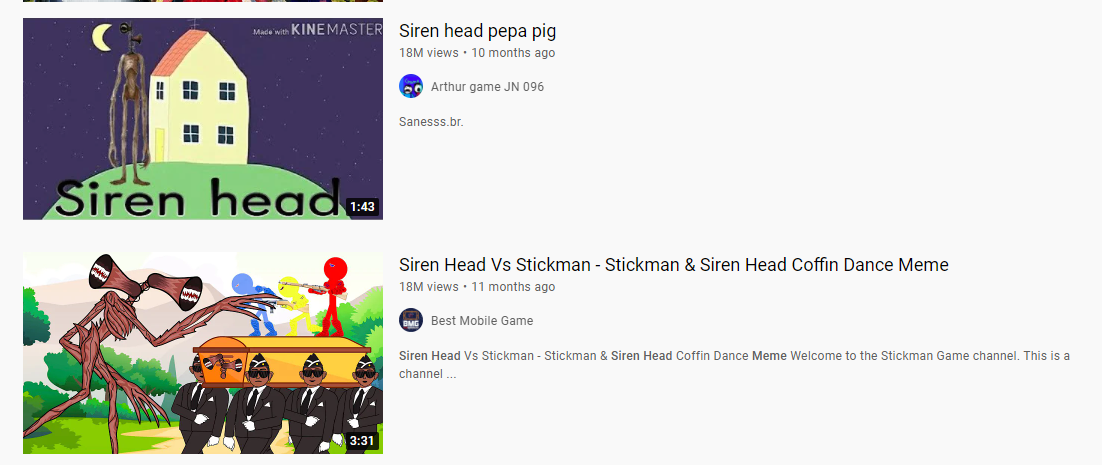




















Kids on the Web in 2021: Infinite creativity